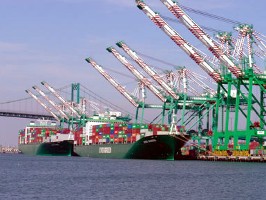Delft University of Technology (TU Delft) in the Netherlands and Jiao Tong University in Shanghai, China will develop a traffic model for shipping in congested port areas, which they hope will provide a better understanding of the ports’ capacity and improve safety. The project is part of a program by the Netherlands Organisation for Scientific Research and the National Natural Science Foundation of China, and will involve engineering departments at each institution.
The need for a model that simulates port traffic is a result of ships becoming larger and moving faster, causing more congestion in the ports. TU Delft engineering professor Han Ligteringen says that more efficient processing of port traffic can effectively increase a port’s capacity.
But the model can also lead to increased safety for ships and crews. “The issue of safety is growing in importance because of the increasing threat of collisions between ships,” says Ligteringen, “caused in part by the increased congestion and its effects on both the environment and the local area.”
Current traffic models do not account for interactions between ships, notes Ligteringen. “They also fail to correctly predict the course variations of individual ships caused by human factors, and changing external conditions, such as fog and wind,” he adds.
The new model will incorporate research at TU Delft on pedestrians. While the methods of propulsion are different, transport and planning professor Winnie Daamen says “just like pedestrians, ships have a great deal of flexibility in terms of the route they can select and how they interact with other ships.”
The model is also expected to include work on game theory, which will soon make it possible to accurately predict the behavior of individual ships and their interactions under varying conditions, such as wind, waves, current, and visibility. The joint team plans to test the model using data from the ports of Rotterdam and Shanghai.
Read More: Math Model Analyzes Moving Bottlenecks in Traffic
* * *


 RSS - Posts
RSS - Posts
You must be logged in to post a comment.